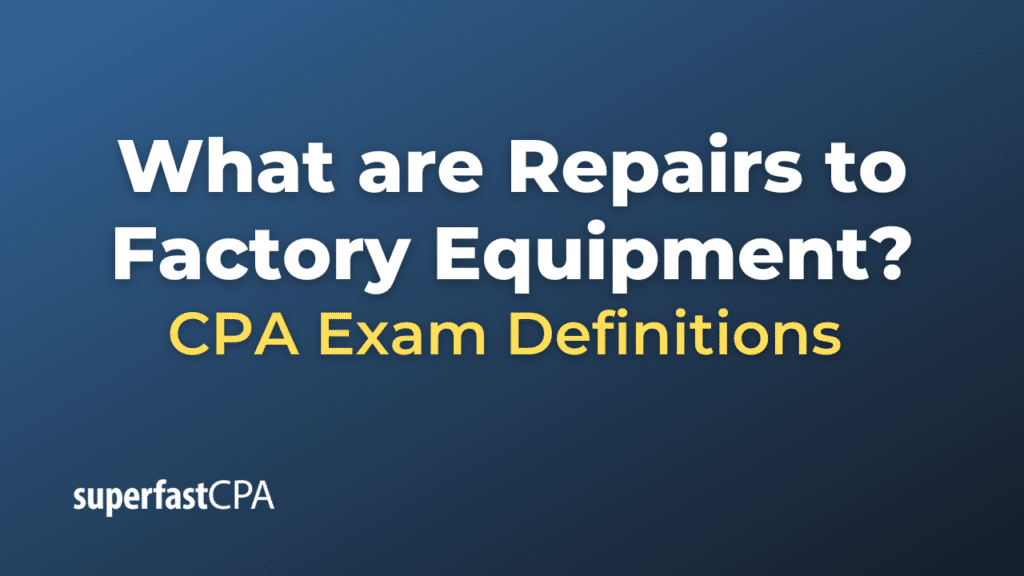Repairs to Factory Equipment
Repairs to factory equipment refer to the costs associated with fixing, maintaining, or restoring manufacturing or industrial equipment so that it remains in operational condition or returns to its prior operational state. This is necessary to ensure smooth and efficient production processes within a factory setting.
Factory equipment can range from large machinery and assembly line components to more minor tools and devices. Over time, due to regular wear and tear or occasional malfunctions, this equipment might need repairs.
Characteristics of Repairs to Factory Equipment:
- Non-Capital Expenditures: Repairs generally do not extend the life of the equipment beyond its original expectancy nor do they improve its functionality beyond its original state. Hence, they are typically expensed in the period they are incurred. If a repair or improvement extends the equipment’s useful life or increases its capacity, it would be considered a capital expenditure and should be capitalized and depreciated over its useful life.
- Overhead Costs: In cost accounting, repairs to factory equipment are often considered as part of factory overhead. These overhead costs are then allocated to the products being produced based on a suitable allocation base, such as machine hours or labor hours.
- Necessity: Regular maintenance and timely repairs are crucial to avoid prolonged downtimes in manufacturing processes, which could result in production backlogs, missed delivery timelines, or increased production costs.
- Types: Repairs could range from minor (like replacing a worn-out belt on a machine) to significant (such as overhauling an entire machine component).
- Frequency: Some repairs are predictable and can be scheduled (like routine maintenance), while others might be unexpected, necessitating immediate attention to prevent further damage or disruptions.
For financial reporting and cost accounting purposes, it’s essential to track and categorize repairs to factory equipment accurately. Properly accounting for these costs ensures that product costs are accurately determined, financial statements are correct, and the health and efficiency of the production processes are regularly assessed.
Example of Repairs to Factory Equipment
Let’s explore a fictional scenario involving a company and its factory equipment repairs.
Modern Widgets Manufacturing Co. produces specialized widgets using a series of machines in its factory. One of its primary machines, the “WidgetMaster 3000,” is crucial for the final assembly process.
- Routine Maintenance:
- Every six months, the WidgetMaster 3000 requires routine maintenance. This involves cleaning, lubricating moving parts, and recalibrating some settings.
- The cost for this semi-annual maintenance is $2,000.
- This amount is recorded as a Repairs and Maintenance Expense in Modern Widgets’ income statement. In terms of cost accounting, it also contributes to the factory overhead, which will be allocated to the cost of producing each widget.
- Unexpected Breakdown:
- One day, a significant component of the WidgetMaster 3000 malfunctions and breaks down.
- The cost to repair the component and bring the machine back to its operational state is $5,000.
- This repair is necessary for the machine to operate but doesn’t enhance its functionality or extend its lifespan. Hence, the $5,000 is recorded as a Repairs and Maintenance Expense.
- Major Overhaul:
- After several years of operation, Modern Widgets decides to perform a major overhaul on the WidgetMaster 3000, replacing several old parts with new, more efficient ones. This overhaul is expected to increase the machine’s efficiency and extend its useful life by another five years.
- The overhaul costs $20,000.
- Due to the nature of this overhaul, it is considered a capital expenditure. The $20,000 is capitalized and added to the machine’s book value on the balance sheet. It will be depreciated over the machine’s new extended useful life.
At the end of the year, Modern Widgets Manufacturing Co.’s income statement will show a Repairs and Maintenance Expense that includes the routine maintenance and unexpected repair costs. Meanwhile, the balance sheet will reflect an increased value in the “WidgetMaster 3000” due to the capitalized cost of the overhaul.
This example helps illustrate how different types of repairs and maintenance activities, as well as major overhauls, are accounted for in a manufacturing setting.












